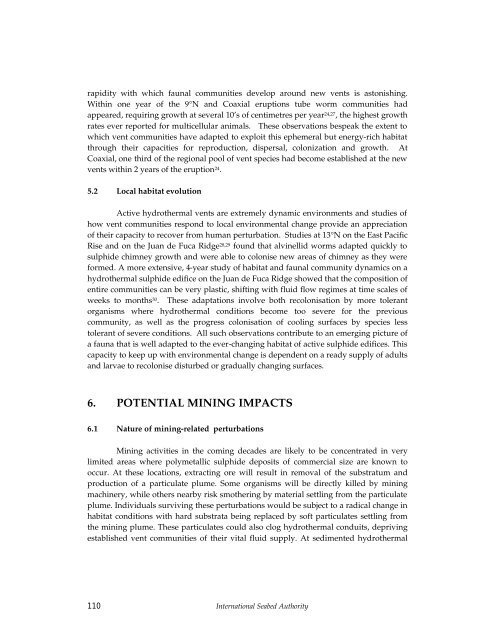Full page fax print - International Seabed Authority
Full page fax print - International Seabed Authority
Full page fax print - International Seabed Authority
You also want an ePaper? Increase the reach of your titles
YUMPU automatically turns print PDFs into web optimized ePapers that Google loves.
apidity with which faunal communities develop around new vents is astonishing.<br />
Within one year of the 9°N and Coaxial eruptions tube worm communities had<br />
appeared, requiring growth at several 10’s of centimetres per year 24,27, the highest growth<br />
rates ever reported for multicellular animals. These observations bespeak the extent to<br />
which vent communities have adapted to exploit this ephemeral but energy-rich habitat<br />
through their capacities for reproduction, dispersal, colonization and growth. At<br />
Coaxial, one third of the regional pool of vent species had become established at the new<br />
vents within 2 years of the eruption 24.<br />
5.2 Local habitat evolution<br />
Active hydrothermal vents are extremely dynamic environments and studies of<br />
how vent communities respond to local environmental change provide an appreciation<br />
of their capacity to recover from human perturbation. Studies at 13°N on the East Pacific<br />
Rise and on the Juan de Fuca Ridge 28,29 found that alvinellid worms adapted quickly to<br />
sulphide chimney growth and were able to colonise new areas of chimney as they were<br />
formed. A more extensive, 4-year study of habitat and faunal community dynamics on a<br />
hydrothermal sulphide edifice on the Juan de Fuca Ridge showed that the composition of<br />
entire communities can be very plastic, shifting with fluid flow regimes at time scales of<br />
weeks to months 30. These adaptations involve both recolonisation by more tolerant<br />
organisms where hydrothermal conditions become too severe for the previous<br />
community, as well as the progress colonisation of cooling surfaces by species less<br />
tolerant of severe conditions. All such observations contribute to an emerging picture of<br />
a fauna that is well adapted to the ever-changing habitat of active sulphide edifices. This<br />
capacity to keep up with environmental change is dependent on a ready supply of adults<br />
and larvae to recolonise disturbed or gradually changing surfaces.<br />
6. POTENTIAL MINING IMPACTS<br />
6.1 Nature of mining-related perturbations<br />
Mining activities in the coming decades are likely to be concentrated in very<br />
limited areas where polymetallic sulphide deposits of commercial size are known to<br />
occur. At these locations, extracting ore will result in removal of the substratum and<br />
production of a particulate plume. Some organisms will be directly killed by mining<br />
machinery, while others nearby risk smothering by material settling from the particulate<br />
plume. Individuals surviving these perturbations would be subject to a radical change in<br />
habitat conditions with hard substrata being replaced by soft particulates settling from<br />
the mining plume. These particulates could also clog hydrothermal conduits, depriving<br />
established vent communities of their vital fluid supply. At sedimented hydrothermal<br />
110 <strong>International</strong> <strong>Seabed</strong> <strong>Authority</strong>

















